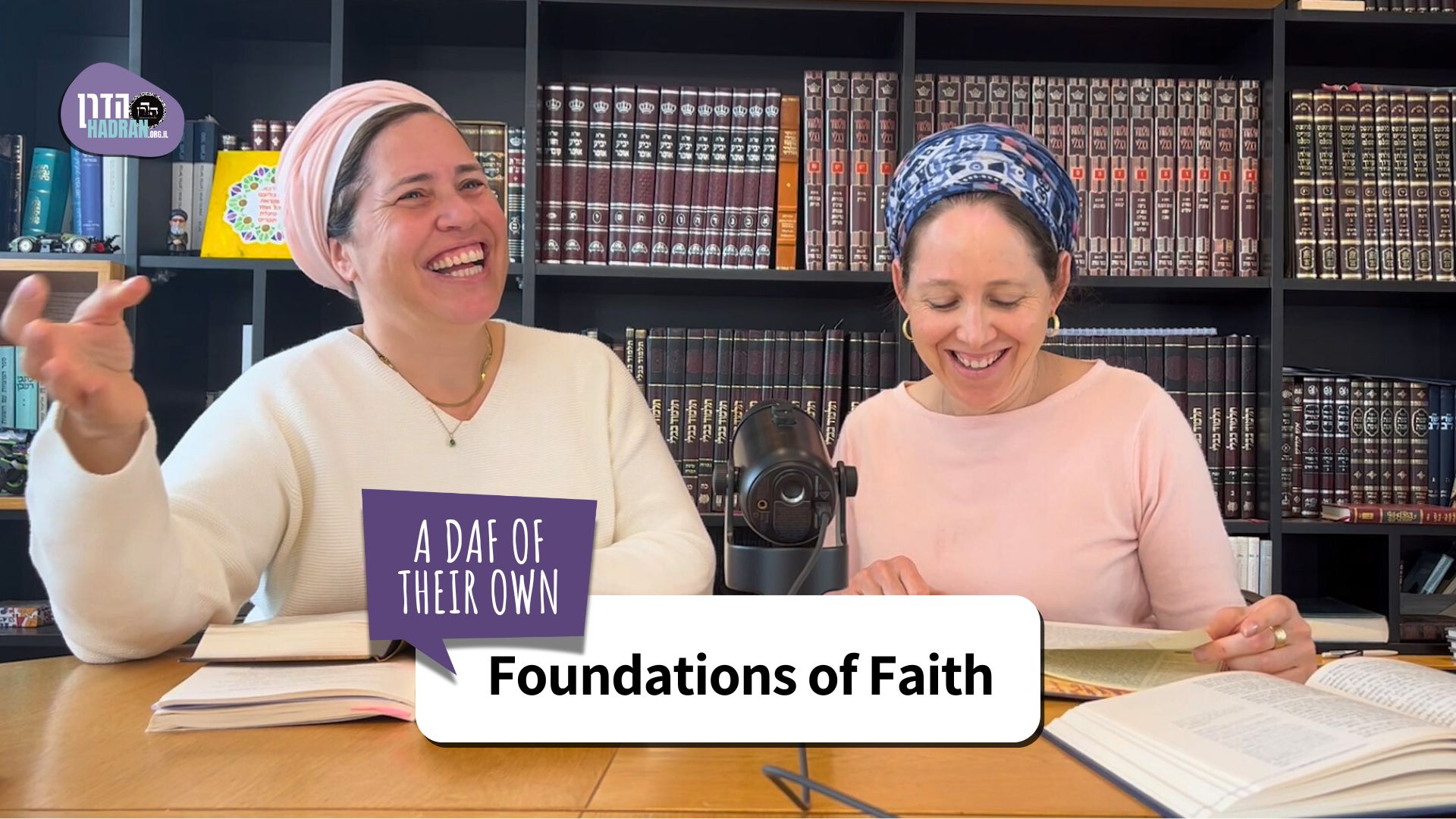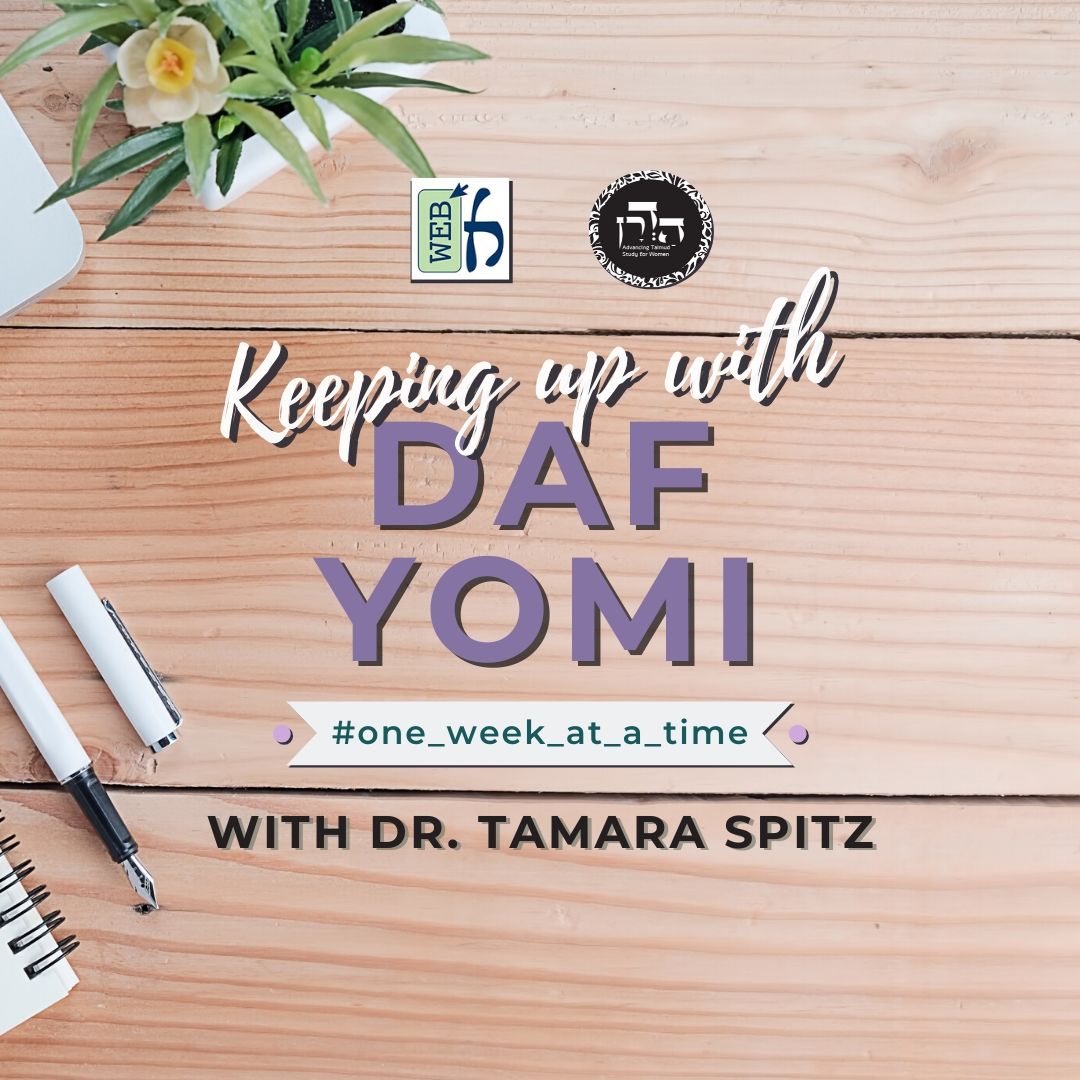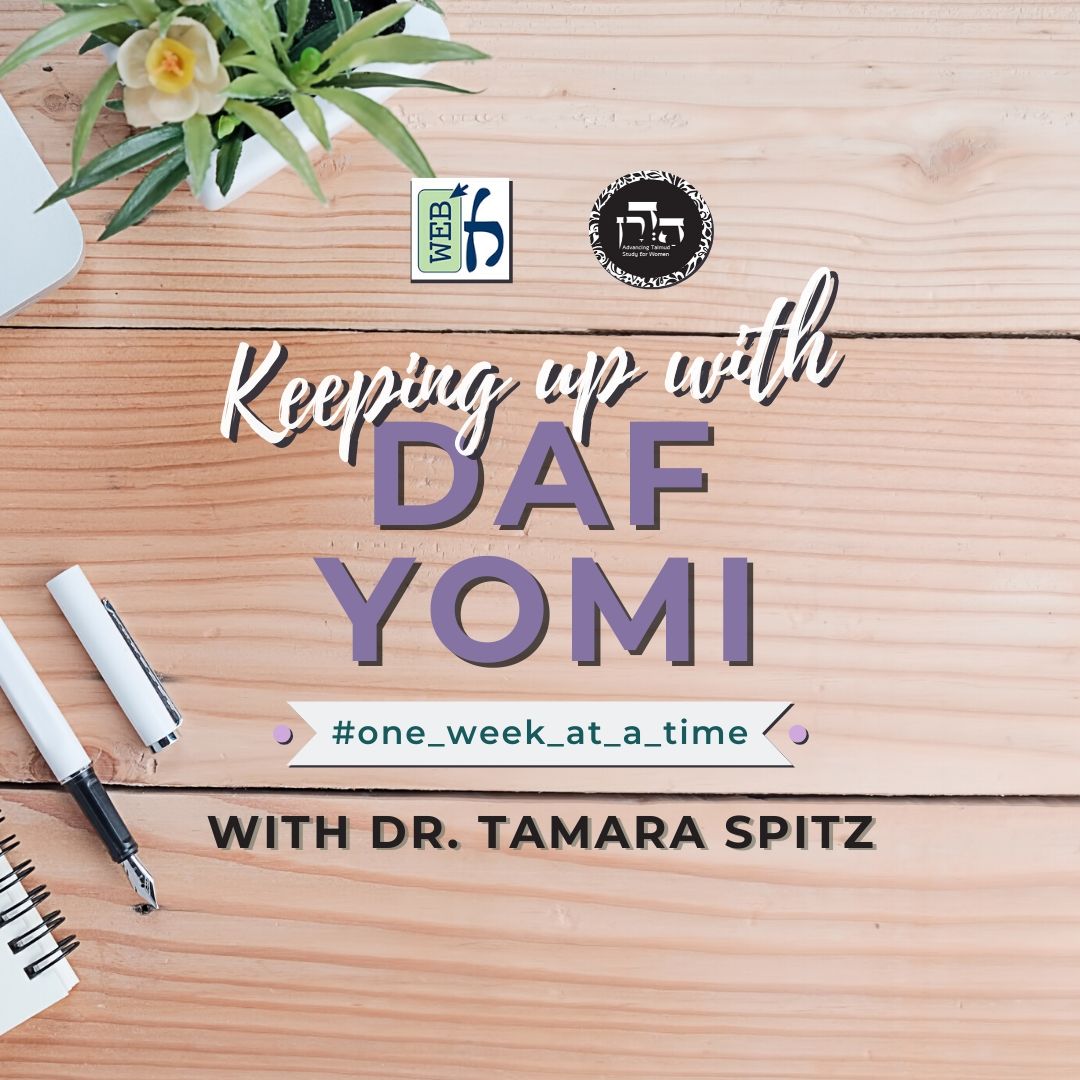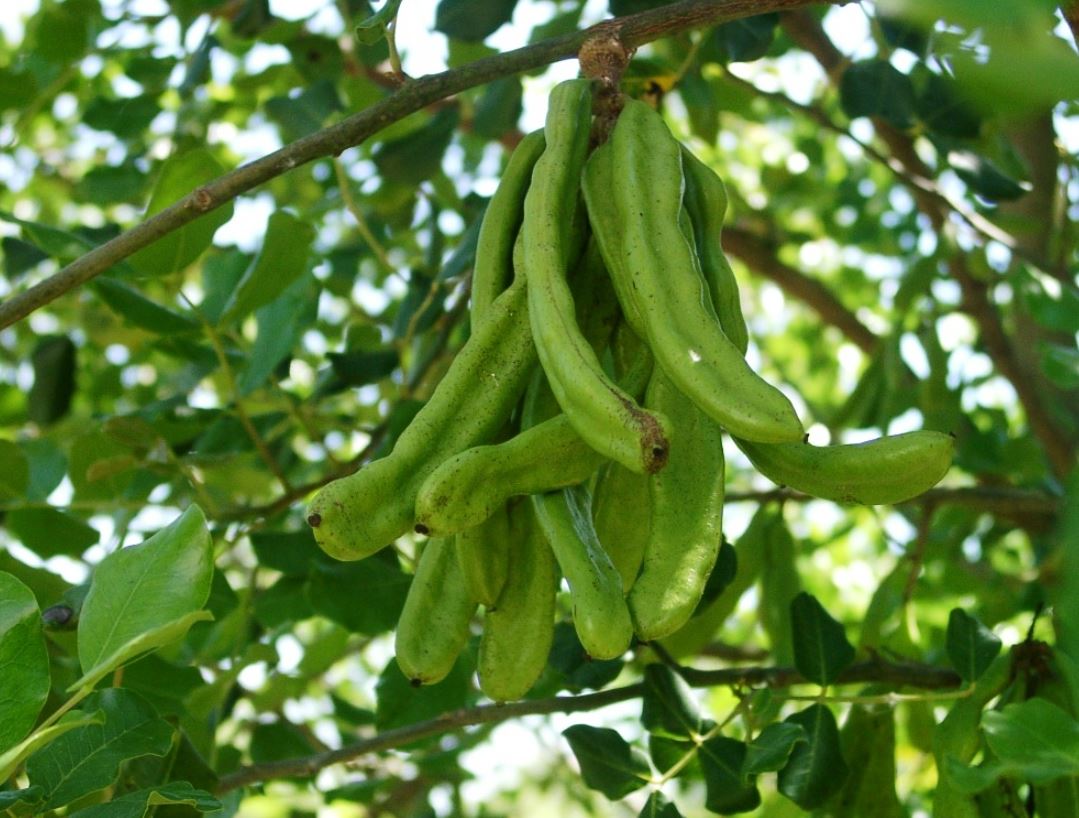This month’s learning is sponsored by Beth Balkany in honor of their granddaughter, Devorah Chana Serach Eichel. “May she grow up to be a lifelong learner.”
This month’s learning is dedicated in memory of Rabbi Dr. Raymond Harari z”l, on his 1st yahrzeit. As an educator, principal of Yeshiva of Flatbush, and community rabbi, he inspired thousands with his wisdom, warmth, and unwavering commitment to Torah.
Want to dedicate learning? Get started here:


Today’s daily daf tools:
This month’s learning is sponsored by Beth Balkany in honor of their granddaughter, Devorah Chana Serach Eichel. “May she grow up to be a lifelong learner.”
This month’s learning is dedicated in memory of Rabbi Dr. Raymond Harari z”l, on his 1st yahrzeit. As an educator, principal of Yeshiva of Flatbush, and community rabbi, he inspired thousands with his wisdom, warmth, and unwavering commitment to Torah.
Today’s daily daf tools:
Delve Deeper
Broaden your understanding of the topics on this daf with classes and podcasts from top women Talmud scholars.
New to Talmud?
Check out our resources designed to help you navigate a page of Talmud – and study at the pace, level and style that fits you.
The Hadran Women’s Tapestry
Meet the diverse women learning Gemara at Hadran and hear their stories.
Temurah 9
בּוּצִינָא טָב מִקָּרָא.
A zucchini now is better than the possibility of a gourd later. There is no reason to give up an animal now for the hope of receiving another later.
מַתְנִי׳ מְמִירִין מִן הַצֹּאן עַל הַבָּקָר, וּמִן הַבָּקָר עַל הַצֹּאן, וּמִן הַכְּבָשִׂים עַל הָעִזִּים, וּמִן הָעִזִּים עַל הַכְּבָשִׂים, מִן הַזְּכָרִים עַל הַנְּקֵבוֹת, וּמִן הַנְּקֵבוֹת עַל הַזְּכָרִים, מִן הַתְּמִימִים עַל בַּעֲלֵי מוּמִין, מִן בַּעֲלֵי מוּמִין עַל הַתְּמִימִים.
MISHNA: It is written: “He shall neither exchange it, nor substitute it, good for bad, or bad for good; and if he substitutes an animal for an animal, then both it and its substitute shall be sacred” (Leviticus 27:10). The mishna enumerates the consecrated and non-sacred animals this verse applies to. One substitutes for consecrated animals from the flock of sheep or goats, and the sanctity takes effect upon animals from the herd of cattle, and one substitutes from the herd and the sanctity takes effect upon animals from the flock. And one substitutes from the sheep and the sanctity takes effect upon the goats, and from the goats upon the sheep; and from the males upon the females, and from the females upon the males; and from the unblemished animals upon the blemished animals, and from the blemished animals upon the unblemished animals.
שֶׁנֶּאֱמַר: ״לֹא יַחֲלִיפֶנּוּ וְלֹא יָמִיר אוֹתוֹ טוֹב בְּרָע אוֹ רַע בְּטוֹב״, וְאֵיזֶהוּ ״טוֹב בְּרָע״? בַּעֲלֵי מוּמִין שֶׁקָּדַם הֶקְדֵּישָׁן אֶת מוּמָן.
The source for this is as it is stated: “He shall neither exchange it, nor substitute it, good for bad, or bad for good” (Leviticus 27:10). And which is the case of good for bad where the substitution takes effect? It is a case where one substitutes for blemished animals whose consecration preceded their blemish. But if an animal was consecrated after it was blemished, substitution for it does not take effect.
גְּמָ׳ מְנָא הָנֵי מִילֵּי? דְּתָנוּ רַבָּנַן: ״בְּהֵמָה בִּבְהֵמָה״ — מִכָּאן שֶׁמְּמִירִין מִן הַצֹּאן עַל הַבָּקָר, וּמִן הַבָּקָר עַל הַצֹּאן, מִן הַכְּבָשִׂים עַל הָעִזִּים, וּמִן הָעִזִּים עַל הַכְּבָשִׂים, וּמִן הַזְּכָרִים עַל הַנְּקֵבוֹת, וּמִן הַנְּקֵבוֹת עַל הַזְּכָרִים, וּמִן בַּעֲלֵי מוּמִין עַל הַתְּמִימִים, וּמִן הַתְּמִימִים עַל בַּעֲלֵי מוּמִין.
GEMARA: From where are these matters derived? They are derived from a verse, as the Sages taught in a baraita: The verse states: “And if he substitutes an animal for an animal, then both it and its substitute shall be sacred” (Leviticus 27:10). When the verse states: “An animal for an animal,” from here it is derived that one substitutes for consecrated animals from the flock and the sanctity takes effect upon animals from the herd, and one likewise substitutes from the herd upon animals from the flock; and one substitutes from the sheep and the sanctity takes effect upon the goats, and from the goats upon the sheep; and from the males upon the females and from the females upon the males; and from the blemished animals upon the unblemished animals and from the unblemished animals upon the blemished animals.
יָכוֹל אֲפִילּוּ קָדַם מוּם לְהֶקְדֵּישָׁן? תַּלְמוּד לוֹמַר: ״לֹא יַחֲלִיפֶנּוּ וְלֹא יָמִיר אֹתוֹ טוֹב בְּרָע אוֹ רַע בְּטוֹב״, וְאֵיזֶהוּ ״טוֹב בְּרָע״? בַּעֲלֵי מוּמִין שֶׁקָּדַם הֶקְדֵּישָׁן אֶת מוּמָן.
One might have thought that this is the halakha even for animals whose blemish preceded their consecration. Therefore, the verse states: “He shall neither exchange it, nor substitute it, good for bad, or bad for good” (Leviticus 27:10), and which is the case of good for bad where the substitution takes effect? It is a case of blemished animals whose consecration preceded their blemish. If an animal was consecrated after it was blemished, substitution for it does not take effect.
מַאי תַּלְמוּדָא? אָמַר אַבָּיֵי: נֵימָא קְרָא ״לֹא יַחֲלִיפֶנּוּ וְלֹא יָמִיר אֹתוֹ טוֹב בְּרָע אוֹ רַע בּוֹ״, ״בְּטוֹב״ אַחְרִינָא לְמָה לִי? שְׁמַע מִינַּהּ: טוֹב מֵעִיקָּרוֹ עוֹשֶׂה תְּמוּרָה, רַע מֵעִיקָּרוֹ אֵין עוֹשֶׂה תְּמוּרָה.
The Gemara discusses the second half of the baraita: What is the biblical derivation that leads to this conclusion? Abaye said that the verse should have stated: He shall neither exchange it, nor substitute it, good for bad, or bad for it. Why do I need another instance of the term “for good”? Learn from this repetition that if the animal is good, i.e., unblemished, from its beginning, before it was consecrated, one can render a substitute for it, but if it is bad from its beginning, one cannot render a substitute for it.
רָבָא אָמַר: תַּרְוַויְיהוּ ״טוֹב״ יַיתּוֹרֵי מְיַיתְּרִי. אִם כֵּן, נִכְתּוֹב קְרָא ״לֹא יַחֲלִיפֶנּוּ וְלֹא יָמִיר אוֹתוֹ בְּרָע אוֹ רַע בּוֹ״, לְמָה לִי לְמִכְתַּב תַּרְוַיְיהוּ ״טוֹב״? חַד ״טוֹב״ — אֲפִילּוּ בְּטוֹב נָמֵי, כִּי מֵמִיר לָקֵי. וְאִידַּךְ ״טוֹב״ — מֵעִיקָּרוֹ עוֹשֶׂה תְּמוּרָה, רַע מֵעִיקָּרוֹ אֵין עוֹשֶׂה תְּמוּרָה.
Rava said: Both instances of the word “good” in the verse are superfluous. If so, let the verse write: He shall neither exchange it, nor substitute it for bad, or bad for it. Why do I need the verse to write both instances of the word “good”? One instance of the word “good” teaches that even if one substitutes a good animal for a good animal, when he effects substitution he is flogged. And the other instance teaches that if the animal is good from its beginning one can render a substitute for it, but if it is bad from its beginning one cannot render a substitute for it.
וְאַבָּיֵי אָמַר: קַל וָחוֹמֶר הוּא, וּמָה טוֹב בְּרָע, דְּעַלּוֹיֵי קָא מְעַלֵּי לֵיהּ — לָקֵי, טוֹב בְּטוֹב, דְּכִי הֲדָדֵי נִינְהוּ — לֹא כׇּל שֶׁכֵּן דְּלָקֵי!
And Abaye said: The first derivation of Rava is unnecessary, as that halakha is already derived by an a fortiori inference, as follows: Just as one who substitutes a good animal for a bad blemished one, where he seeks to improve the standing of the consecrated animal by making it fit for sacrifice, is nevertheless flogged, is it not all the more so the case that one who substitutes a good animal for a good animal, which are equivalent to each other, should be flogged?
וְרָבָא — אֵין עוֹנְשִׁין מִן הַדִּין, וְאַבַּיֵּי אָמַר לָךְ: הָא לָאו דִּינָא הוּא, מִי גָּרַע טוֹב מֵרַע?
And Rava would respond that an a fortiori inference is not sufficient, as one does not administer punishment based on an a fortiori inference. Punishment with lashes can be based only on the explicit wording of a verse. And Abaye could say to you that this is not a mere logical derivation, but it is included in the language of the verse, as, is substituting a good, unblemished, animal less of an act of substitution than substituting a bad one? The prohibition stated in the verse clearly applies in either case.
תָּנוּ רַבָּנַן: ״לֹא יַחֲלִיפֶנּוּ״ בְּשֶׁל אֲחֵרִים, ״וְלֹא יָמִיר אוֹתוֹ״ בְּשֶׁל עַצְמוֹ. וְלִכְתּוֹב ״לֹא יַחֲלִיפֶנּוּ״, וְלָא בָּעֵי ״לֹא יָמִיר אוֹתוֹ״!
§ The Sages taught in a baraita that when the verse states: “He shall neither exchange it,” this is referring to substituting one’s animal for that of others. The phrase “nor substitute it” is referring to substituting one’s non-sacred animal for his own sacred one. The Gemara objects: But let the verse write simply: “He shall not exchange it,” and there will be no need to write: “Nor substitute it,” as the prohibition against substituting for one’s own animal can be inferred a fortiori from the prohibition against substituting for another’s animal.
אִי כְּתַב הָכִי — הֲוָה אָמֵינָא: תֵּצֵא זוֹ וְתִכָּנֵס זוֹ הוּא דְּתִילְקֵי, אֲבָל מֵמִיר דְּתַרְוַויְיהוּ קָא מַקְדֵּישׁ לְהוּ — אֵימָא לָא לָקֵי. קָא מַשְׁמַע לַן.
The Gemara explains: If the verse had written the prohibition in that manner, I would say that one is flogged only if he stated: This consecrated animal should leave its consecrated status and this non-sacred animal should enter in its stead. But if one effects substitution by simply stating: This is a substitute for that, as he has consecrated both of the animals, I would say that he is not flogged. The additional phrase in the verse teaches us that he is flogged in this case as well.
הַאי בְּשֶׁל אֲחֵרִים, הֵיכִי דָּמֵי? אִי נֵימָא בְּהֵמָה דְּהֶקְדֵּשׁ דִּידֵיהּ, וְחוּלִּין דְּעָלְמָא — מִי מָצֵי מַקְדֵּישׁ? ״אִישׁ כִּי יַקְדִּישׁ אֶת בֵּיתוֹ קֹדֶשׁ לַה׳״ אָמַר רַחֲמָנָא, מָה בֵּיתוֹ בִּרְשׁוּתוֹ, אַף כֹּל בִּרְשׁוּתוֹ. וְאֶלָּא בְּהֵמָה דְּהֶקְדֵּשׁ דְּעָלְמָא, וְחוּלִּין דִּידֵיהּ — מִי מַתְפֵּיס בְּדָבָר שֶׁאֵינוֹ שֶׁלּוֹ?
The Gemara explains: What are the circumstances of substituting his animal for that of others? If we say that the consecrated animal is his and the non-sacred animal belongs to others, is he able to consecrate an animal in this manner? The Merciful One states in the Torah: “When a man shall consecrate his house to be sacred unto the Lord” (Leviticus 27:14), which teaches that just as his house is in his possession, so too, any item one desires to consecrate must be in his possession. One cannot consecrate another’s animal. But rather, if we say that the consecrated animal belongs to others, and the non-sacred animal is his, can one effect substitution for an item that is not his?
לְעוֹלָם בִּבְהֵמָה דְּהֶקְדֵּשׁ דְּעָלְמָא, וְחוּלִּין דִּידֵיהּ, כְּגוֹן דְּאָמַר מָרֵיהּ דִּבְהֵמָה דְּהֶקְדֵּשׁ: ״כׇּל הָרוֹצֶה לְהָמִיר בִּבְהֶמְתּוֹ יָבֹא וְיָמִיר״.
The Gemara explains: Actually, the baraita is referring to a consecrated animal of others and his non-sacred animal, and it is a case where the owner of the consecrated animal said that whoever wants to effect substitution for his animal can come and effect substitution. In this case, one can effect substitution even for a consecrated item that is not his.
מַתְנִי׳ מְמִירִין אֶחָד בִּשְׁנַיִם, וּשְׁנַיִם בְּאֶחָד, אֶחָד בְּמֵאָה, וּמֵאָה בְּאֶחָד. רַבִּי שִׁמְעוֹן אוֹמֵר: אֵין מְמִירִין אֶלָּא אֶחָד בְּאֶחָד, שֶׁנֶּאֱמַר: ״וְהָיָה הוּא וּתְמוּרָתוֹ יִהְיֶה קֹּדֶשׁ״, מָה ״הוּא״ מְיוּחָד, אַף הִיא מְיוּחֶדֶת.
MISHNA: One substitutes one non-sacred animal for two consecrated animals and two non-sacred animals for one consecrated animal, and one substitutes one non-sacred animal for one hundred consecrated animals and one hundred non-sacred animals for one consecrated animal. Rabbi Shimon says: One substitutes only one non-sacred animal for one consecrated animal, as it is stated: “Then both it and its substitute shall be sacred” (Leviticus 27:10). Just as “it” indicates one specific animal, so too, its substitute can be only one specific animal.
גְּמָ׳ מְנָא הָנֵי מִילֵּי? דְּתָנוּ רַבָּנַן: ״בְּהֵמָה בִּבְהֵמָה״ — מִכָּאן שֶׁמְּמִירִין אֶחָד בִּשְׁנַיִם, וּשְׁנַיִם בְּאֶחָד, אֶחָד בְּמֵאָה, וּמֵאָה בְּאֶחָד. רַבִּי שִׁמְעוֹן אוֹמֵר: אֵין מְמִירִין אֶלָּא אֶחָד בְּאֶחָד, שֶׁנֶּאֱמַר ״בְּהֵמָה בִּבְהֵמָה״, וְלֹא בְּהֵמָה בִּבְהֵמוֹת, וְלֹא בְּהֵמוֹת בִּבְהֵמָה.
GEMARA: With regard to the dispute between the first tanna and Rabbi Shimon, the Gemara explains: From where are these matters derived? As the Sages taught in a baraita: The verse states: “An animal for an animal” (Leviticus 27:10). From here it is derived that one substitutes one non-sacred animal for two consecrated animals and two non-sacred animals for one consecrated animal, and one non-sacred animal for one hundred consecrated animals and one hundred non-sacred animals for one consecrated animal. Rabbi Shimon says: One substitutes only one non-sacred animal for one consecrated animal, as it is stated: “An animal [behema] for an animal,” and it is not stated: An animal for animals [bivehemot], nor: Animals for an animal.
אָמַר לוֹ: מָצִינוּ בְּהֵמוֹת שֶׁקְּרוּיָה ״בְּהֵמָה״, שֶׁנֶּאֱמַר: ״וּבְהֵמָה רַבָּה״. וְרַבִּי שִׁמְעוֹן — ״בְּהֵמָה רַבָּה״ אִיקְּרִי, ״בְּהֵמָה״ סְתָם לָא אִיקְּרִי.
The first tanna said to Rabbi Shimon: We have found that a group of animals is called by the singular term behema, as it is stated: “And many animals [uvhema rabba]” (Jonah 4:11). The Gemara notes: And Rabbi Shimon could respond that many animals are indeed called “behema rabba,” but they are not called “behema” without further specification.
וְטַעְמָא דְּרַבִּי שִׁמְעוֹן מִשּׁוּם ״בְּהֵמָה״ הוּא? וְהָא טַעְמָא דְּרַבִּי שִׁמְעוֹן מִשּׁוּם ״הוּא״, מָה ״הוּא״ מְיוּחָד — אַף תְּמוּרָה מְיוּחֶדֶת!
The Gemara asks: And is the reason of Rabbi Shimon really due to the verse’s phrase “an animal for an animal”? But isn’t the reason of Rabbi Shimon, as explained in the mishna, due to the word “it” in the verse? Just as “it” indicates one specific animal, so too, its substitute can be only one specific animal.
מֵעִיקָּרָא אָמַר לָהֶן רַבִּי שִׁמְעוֹן מִן ״וְהָיָה הוּא וּתְמוּרָתוֹ״, וְכִי חֲזָא דְּדָרְשִׁי רַבָּנַן מִ״בְּהֵמָה בִּבְהֵמָה״, אָמַר לָהֶם אִיהוּ: מֵהָתָם נָמֵי מָצֵינַן לְמֵילַף טַעְמָא דִּידִי.
The Gemara answers: Initially, Rabbi Shimon stated his opinion to the Sages by drawing support from the phrase: “Then both it and its substitute.” But when he saw that the Rabbis taught their opinion drawing support from the phrase “an animal for an animal,” he said to them: You can learn the reason for my opinion from there too.
אָמַר רֵישׁ לָקִישׁ: מוֹדֶה רַבִּי שִׁמְעוֹן שֶׁמְּמִירִין וְחוֹזְרִין וּמְמִירִין, מַאי טַעְמָא? קְדוּשָּׁה רִאשׁוֹנָה דְּהֶקְדֵּשׁ לְהֵיכָן הָלְכָה?! וְרַבִּי יוֹחָנָן אָמַר: כְּשֵׁם שֶׁאֵין מְמִירִין שְׁנַיִם בְּאֶחָד, כֵּן אֵין מְמִירִין וְחוֹזְרִין וּמְמִירִין.
Reish Lakish says: Although he holds that one cannot substitute two animals for one, Rabbi Shimon concedes that one can effect substitution once and then effect substitution again for the same consecrated animal. What is the reason for this? The reason is that one can ask: Where has the initial consecration of the consecrated animal gone? Even after one effects substitution, it remains consecrated as it was before. And Rabbi Yoḥanan says: Rabbi Shimon maintains that just as one cannot substitute two animals for one, so too, one cannot effect substitution and then effect substitution again using the same consecrated animal.
תַּנְיָא כְּוָותֵיהּ דְּרַבִּי יוֹחָנָן, תַּנְיָא כְּוָותֵיהּ דְּרֵישׁ לָקִישׁ. תַּנְיָא כְּוָותֵיהּ דְּרַבִּי יוֹחָנָן: כְּשֵׁם שֶׁאֵין מְמִירִין אֶחָד בִּשְׁנַיִם, כָּךְ אֵין מְמִירִין וְחוֹזְרִין וּמְמִירִין. תַּנְיָא כְּוָותֵיהּ דְּרֵישׁ לָקִישׁ: יָכוֹל כְּשֵׁם שֶׁאָמַר רַבִּי שִׁמְעוֹן שֶׁאֵין מְמִירִין שְׁנַיִם בְּאֶחָד, כָּךְ אֵין מְמִירִין וְחוֹזְרִין וּמְמִירִין — תַּלְמוּד לוֹמַר: ״וְהָיָה הוּא וּתְמוּרָתוֹ״, אֲפִילּוּ בְּמֵאָה.
The Gemara comments: It is taught in a baraita in accordance with the opinion of Rabbi Yoḥanan, and it is taught in a baraita in accordance with the opinion of Reish Lakish. It is taught in a baraita in accordance with the opinion of Rabbi Yoḥanan: Just as one cannot substitute one animal for two, so too, one cannot effect substitution and then effect substitution again. It is taught in a baraita in accordance with the opinion of Reish Lakish: One might have thought that just as Rabbi Shimon said that one cannot substitute two animals for one, so too, one cannot effect substitution and then effect substitution again. Therefore, the verse states: “Then both it and its substitute” (Leviticus 27:10), which teaches that one can effect substitution with even one hundred non-sacred animals.
בָּעֵי רַבִּי אָבִין: לְדִבְרֵי הָאוֹמֵר ״אֵין מְמִירִין וְחוֹזְרִין וּמְמִירִין״, הִפְרִישׁ אָשָׁם לְהִתְכַּפֵּר בּוֹ, וְהֵמִיר בּוֹ,
Rabbi Avin raises a dilemma: According to the statement of the one who says that one cannot effect substitution once and then effect substitution again, if one designated an animal as a guilt offering with which to atone and effected substitution for it,
וְהוּמַם וְחִלְּלוֹ עַל אַחֵר, וְנִתְכַּפֵּר בְּאָשָׁם אַחֵר, וְנִיתַּק לְעוֹלָה — מַהוּ שֶׁיָּמִיר בּוֹ?
and the original guilt offering became blemished, and he desacralized it by transferring its sanctity onto another animal, which was then lost, and the owner achieved atonement by bringing another, third, animal as a guilt offering, and then the second animal was found and was consigned to be sacrificed as a burnt offering, as is the case for any guilt offering whose owner has achieved atonement by means of another offering, what is the halakha as to whether he can effect substitution for the second animal? Since this animal’s sanctity stems from that of the original blemished animal, and he had already effected a substitute for that original animal, perhaps he cannot now substitute for the second animal, as this would constitute repeat substitution.
אָמַר אַבָּיֵי: מַאי קָא מִיבַּעְיָא לֵיהּ? אִי שְׁנֵי גוּפִים וּקְדוּשָּׁה אַחַת — תִּיבְּעֵי לֵיהּ בְּלֹא מִתְכַּפֵּר.
Abaye said: What is the dilemma he is raising? If his essential dilemma concerns the fact that there are two bodies, i.e., two different animals, then the dilemma would stand even if the original animal and the replacement were of one type of sanctity. If so, let the dilemma be raised even in a case where he did not achieve atonement by another guilt offering, and the second animal remained a guilt offering, rather than being consigned to be sacrificed as a burnt offering.
אִי שְׁתֵּי קְדוּשּׁוֹת, וְגוּף אֶחָד — תִּיבְּעֵי לֵיהּ בְּלֹא הוּמַם!
And if the dilemma is due to the fact that there are two types of sanctity, it would stand even if it was only one body. If so, let the dilemma be raised even where the animal did not become blemished but was simply lost and found after the owner atoned by means of another animal, and it was thereby consigned to be sacrificed as a burnt offering. Why did Rabbi Avin present such a complex case?
וְרַבִּי אָבִין, חֲדָא מִגּוֹ חֲדָא קָמִיבַּעְיָא לֵיהּ, וְאִם תִּימְצֵי לוֹמַר: שְׁנֵי גוּפִין וּקְדוּשָּׁה אַחַת — לָא, מִשּׁוּם דִּבְהָהִיא קְדוּשָּׁה הָא אִיתְּמַר בַּהּ חֲדָא זִימְנָא. שְׁנֵי גוּפִין וּשְׁתֵּי קְדוּשּׁוֹת מַהוּ? תֵּיקוּ.
The Gemara explains: Rabbi Avin raises one dilemma as a result of the anticipated solution to another dilemma: If you say that in the case of two bodies and one type of sanctity it is not possible to effect substitution on the second animal, perhaps that is because this sanctity already had been substituted one time. If so, what is the halakha in the case of two bodies and two types of sanctity? Is the offering changed enough to enable another substitution for it? The Gemara concludes: The dilemma shall stand unresolved.
לִישָּׁנָא אַחֲרִינָא, בָּעֵי רַבִּי אָבִין לְרַבִּי יוֹחָנָן: דְּאָמַר אֵין מְמִירִין וְחוֹזְרִין וּמְמִירִין — הִפְרִישׁ אָשָׁם לְהִתְכַּפֵּר בּוֹ, וְהֵמִיר בּוֹ, וְהוּמַם וְחִלְּלוֹ עַל אַחֵר, מַהוּ שֶׁיַּחְזוֹר וְיָמִיר?
The Gemara presents an alternative version of the previous dilemma. Rabbi Avin raises a dilemma: According to the opinion of Rabbi Yoḥanan, who said that Rabbi Shimon holds that one cannot effect substitution and then effect substitution again for the same animal, if one designated an animal as a guilt offering with which to achieve atonement and substituted for it, and the initial guilt offering became blemished and he desacralized it by transferring its sanctity onto another animal, what is the halakha as to whether he can then effect substitution for this last animal? On the one hand, it is a different animal; on the other hand, it possesses the same sanctity.
נִתְכַּפֵּר בְּאָשָׁם אַחֵר, וְנִיתַּק זֶה לְעוֹלָה, מַהוּ שֶׁיַּחֲזִיר וְיָמִיר?
Rabbi Avin raises another dilemma: If the first animal was lost and the owner achieved atonement by bringing another as a guilt offering, and the first animal was found and was consigned to be sacrificed as a burnt offering, what is the halakha as to whether he can then effect substitution for it? On the one hand, it is the same animal; on the other hand, it possesses a different type of sanctity.
אָמַר אַבָּיֵי: הֵי קָא מִיבַּעְיָא לֵיהּ? קְדוּשָּׁה אַחֶרֶת בְּאוֹתוֹ הַגּוּף — לָא נִיבְעֵי הוּמַם וְחִלְּלוֹ בְּאַחֵר! אִי גּוּף (אֶחָד) [אַחֵר] בְּאוֹתָהּ קְדוּשָּׁה — לָא נִיבְעֵי נִתְכַּפֵּר בְּאָשָׁם אַחֵר!
Abaye said: Which of these two is the essential dilemma he is raising? If his dilemma concerns a case of another type of sanctity in the same body, he should not raise the dilemma in the case where the initial guilt offering became blemished and he desacralized it by transferring its sanctity onto another animal. And if his dilemma concerns a case of another body with the same sanctity, he should not raise the dilemma in the case where the owner achieved atonement by bringing another animal as a guilt offering.
וְרַבִּי אָבִין, חֲדָא מִגּוֹ חֲדָא קָא מִיבַּעְיָא לֵיהּ: הוּמַם וְחִלְּלוֹ עַל אַחֵר, מַהוּ שֶׁיַּחֲזוֹר וְיָמִיר? מִי אָמְרִינַן: בְּאָשָׁם רִאשׁוֹן הוּא דְּאֵין חוֹזֵר וּמֵמִיר, אֲבָל בְּגוּף (אֶחָד) [אַחֵר], אַף עַל גַּב דְּקַדִּישׁ אוֹתָהּ קְדוּשָּׁה — חוֹזֵר וּמֵמִיר, אוֹ דִלְמָא: כֹּל בְּאוֹתָהּ קְדוּשָּׁה אֵין חוֹזֵר וּמֵמִיר?
The Gemara explains: Rabbi Avin raises one dilemma as a result of the anticipated solution to another dilemma, as follows: If the initial guilt offering became blemished and he desacralized it by transferring its sanctity onto another animal, what is the halakha as to whether he can then effect substitution for the second animal? Do we say that it is with the first guilt offering that he cannot effect substitution again, but with another body, even though it is sanctified with the same type of sanctity, he can effect substitution again? Or perhaps we say that with regard to any animal with the same type of sanctity, he cannot effect substitution again?
וְאִם תִּימְצָא לוֹמַר הַדִּין גּוּף (אֶחָד) [אַחֵר], כֵּיוָן דִּבְאוֹתָהּ קְדוּשָּׁה קָאֵים — אֵין חוֹזֵר וּמֵמִיר, אֶלָּא נִתְכַּפֵּר בְּאָשָׁם אַחֵר, וְנִיתַּק זֶה רִאשׁוֹן לְעוֹלָה, מַהוּ שֶׁיַּחֲזִיר וְיָמִיר בּוֹ?
And if you say that with regard to this other body, since it maintains the same type of sanctity as the original animal one cannot effect substitution again, but what then of a case where the first animal was lost and the owner achieved atonement by bringing another animal as a guilt offering, and this first animal was then found and was consigned to be sacrificed as a burnt offering? What is the halakha as to whether he can effect substitution again for the same animal, since now its sanctity has changed?
מִי אָמְרִינַן: כִּי אֵין מֵמִיר וְחוֹזֵר וּמֵמִיר — הָנֵי מִילֵּי אוֹתוֹ הַגּוּף בְּאוֹתָהּ קְדוּשָּׁה, אֲבָל אוֹתוֹ הַגּוּף בִּקְדוּשָּׁה אַחֶרֶת — חוֹזֵר וּמֵמִיר, אוֹ דִלְמָא: אַף עַל קְדוּשָּׁה אַחֶרֶת, כֵּיוָן דְּאוֹתוֹ הַגּוּף הוּא — אֵין חוֹזֵר וּמֵמִיר? תֵּיקוּ.
The Gemara elaborates: Do we say that when Rabbi Yoḥanan states that the owner cannot effect substitution and then effect substitution again, this statement applies to the same body with the same type of sanctity, but as for the same body with another type of sanctity, he can effect substitution again? Or perhaps we say that even concerning another type of sanctity, since it is the same body, he cannot effect substitution again with it. The Gemara concludes: The dilemma shall stand unresolved.
אָמַר רַבִּי יְהוֹשֻׁעַ בֶּן לֵוִי: הֶקְדֵּשׁ רִאשׁוֹן מוֹסִיף חוֹמֶשׁ, וְאֵין הֶקְדֵּשׁ שֵׁנִי מוֹסִיף חוֹמֶשׁ.
§ The Gemara cites a similar discussion. Rabbi Yehoshua ben Levi says: One who redeems an animal that was originally consecrated as an offering and developed a blemish must pay an amount equivalent to its value and add an additional one-fifth of its value. But one who redeems an animal that was consecrated second, i.e., in place of a desacralized blemished offering, and then developed a blemish itself, must pay an amount equivalent to its value but does not add an additional one-fifth of its value.
אָמַר רַב פָּפָּא: מַאי טַעְמָא דְּרַבִּי יְהוֹשֻׁעַ בֶּן לֵוִי? אָמַר קְרָא: ״וְאִם הַמַּקְדִּישׁ יִגְאַל אֶת בֵּיתוֹ וְיָסַף חֲמִישִׁית״ — מַקְדִּישׁ, וְלֹא הַמַּתְפִּיס.
Rav Pappa said: What is the reasoning of Rabbi Yehoshua ben Levi? The verse states: “And if he that consecrated it will redeem his house, then he shall add the fifth part of the money of your valuation unto it, and it shall be his” (Leviticus 27:15), from which Rabbi Yehoshua ben Levi infers that the requirement to pay an additional one-fifth applies to one who consecrates an item directly, but not to the one who applies the sanctity of another item to it.
בָּעֵי רַבִּי אָבִין: הִפְרִישׁ אָשָׁם לְהִתְכַּפֵּר בּוֹ, וְהוּמַם, וְהוֹסִיף עָלָיו חוֹמֶשׁ, וְחִלְּלוֹ חֲבֵירוֹ, וְנִתְכַּפֵּר בְּאָשָׁם אַחֵר, וְנִיתַּק זֶה לְעוֹלָה — מַהוּ שֶׁיּוֹסִיף עָלָיו חוֹמֶשׁ?
Rabbi Avin raises a dilemma concerning a similar matter: If one designated an animal as a guilt offering by which to achieve atonement and it became blemished, and he added one-fifth to its value and desacralized it, and he then used the consecrated money to purchase another guilt offering, which was then lost, and the owner achieved atonement by bringing another, third, animal as a guilt offering, and the second animal was found and consigned to be sacrificed as a burnt offering, and then it developed a blemish, what is the halakha as to whether the owner must add one-fifth to its value when he redeems it?
אָמַר אַבָּיֵי: מַאי קָא מִיבַּעְיָא לֵיהּ? אִי שְׁנֵי גוּפִין וּקְדוּשָּׁה אַחַת קָא מִיבַּעְיָא לֵיהּ — תִּיבְּעֵי לֵיהּ בְּלֹא נִתְכַּפֵּר!
Abaye said: What is the dilemma he is raising? If he is raising a dilemma with regard to two bodies, i.e., two different animals, the problem should stand even if both are of one type of sanctity. If so, let the dilemma be raised even in a case where he did not achieve atonement through another guilt offering, and the second animal was never consigned to be sacrificed as a burnt offering.
אִי שְׁתֵּי קְדוּשּׁוֹת, וְגוּף אֶחָד קָא מִיבַּעְיָא לֵיהּ — תִּיבְּעֵי בְּלֹא הוּמַם!
And if he is raising a dilemma with regard to two types of sanctity, it should apply even in the case of one body. If so, let the dilemma be raised even in a case where the original animal did not become blemished but was simply lost and found after the owner atoned by means of another offering and thereby consigned the original animal to be sacrificed as a burnt offering.
וְרַבִּי אָבִין, חֲדָא מִגּוֹ חֲדָא קָמִיבַּעְיָא לֵיהּ: אִם תִּימְצָא לוֹמַר שְׁנֵי גוּפִין וּקְדוּשָּׁה אַחַת לָא — מִשּׁוּם דִּבְהָהִיא קְדוּשָּׁה אִיתּוֹסַף בַּהּ חֲדָא זִימְנָא חוֹמֶשׁ, שְׁנֵי גוּפִין וּשְׁתֵּי קְדוּשּׁוֹת מַאי? תֵּיקוּ.
The Gemara explains that Rabbi Avin raises one dilemma as a result of the anticipated solution to another dilemma, as follows: If you say that in a case of two bodies and one type of sanctity the owner does not add one-fifth, perhaps that is because one-fifth was already added once to redeem an animal with that type of sanctity. If so, what is the halakha in the case of two bodies and two types of sanctity? Perhaps, since the second animal possesses a different sanctity, it is considered to possess its own original sanctity, rather than derivative sanctity, and therefore one who redeems it adds one-fifth. The Gemara concludes: The dilemma shall stand unresolved.
לִישָּׁנָא אַחֲרִינָא, בָּעֵי רַבִּי אָבִין: הִפְרִישׁ אָשָׁם לְהִתְכַּפֵּר בּוֹ, וְהוּמַם וְחִלְּלוֹ עַל אַחֵר וְהוֹסִיף חוֹמֶשׁ, נִתְכַּפְּרוּ בְּאָשָׁם אַחֵר, וְנִיתַּק זֶה לְעוֹלָה — מַהוּ שֶׁיּוֹסִיף עָלָיו חוֹמֶשׁ?
The Gemara presents an alternative version of the previous dilemma. Rabbi Avin raises a dilemma: If one designated an animal as a guilt offering with which to achieve atonement, and it became blemished and he desacralized it by transferring its sanctity onto another animal, and he added one-fifth of its value, and the second animal was lost and the owner achieved atonement by bringing another, third, animal as a guilt offering, and the second animal was found and was consigned to be sacrificed as a burnt offering, and then it developed a blemish, what is the halakha as to whether the owner must add one-fifth to its value when he redeems it?
אָמַר אַבָּיֵי: הָדֵין קָא מִיבַּעְיָא לֵיהּ, אִי קְדוּשָּׁה אַחֶרֶת בְּאוֹתוֹ הַגּוּף קָא מִיבַּעְיָא לֵיהּ — לָא נִיבְּעֵי לֵיהּ הוּמַם, אִי גּוּף (אֶחָד) [אַחֵר] בְּאוֹתָהּ קְדוּשָּׁה כּוּ׳.
Abaye said: Which of these two is the essential dilemma he is raising? If he raises a dilemma with regard to the case of another type of sanctity in the same body, he should not raise the dilemma about a case where the initial guilt offering became blemished and he transferred its sanctity to another animal. And if his essential dilemma concerns the case of another body with the same type of sanctity, he could pose his dilemma with regard to a case where the second animal was not lost and found and consigned to be a burnt offering.
וְחִלְּלוֹ עַל אַחֵר, מַהוּ שֶׁיּוֹסִיף עָלָיו חוֹמֶשׁ? מִי אָמְרִינַן: בְּאָשָׁם קַמָּא הוּא דְּמוֹסֵיף, אֲבָל בְּגוּף (אֶחָד) [אַחֵר], אַף עַל גַּב דְּקָאֵים בְּאוֹתָהּ קְדוּשָּׁה, [אֵין] מוֹסִיף חוֹמֶשׁ,
The Gemara explains that Rabbi Avin raises one dilemma as a result of the anticipated solution to another dilemma. If the initial guilt offering became blemished and he desacralized it by transferring its sanctity onto another, second, animal, what is the halakha as to whether the owner must add one-fifth to its value when he redeems it? Do we say that with regard to a second redemption of the first guilt offering he does not add one-fifth, since it is the same body and the same sanctity, but here, when it is another body, even though it maintains the same type of sanctity as the initial animal, he adds one-fifth, as it is considered to be directly consecrated?







































